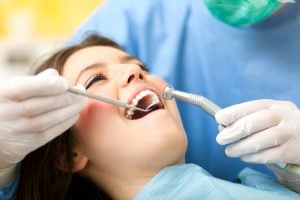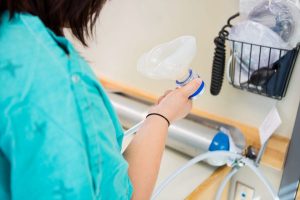Laughing gas is commonly used as a mild sedative in dentistry to relieve pain and help people relax during complex procedures like root canals, wisdom teeth extractions, and even simpler procedures such as a dental cleaning. Certain dental procedures can make some patients feel anxious and scared and may also produce extreme pain and discomfort. Sedatives like laughing gas can help these individuals experience more relaxing, comfortable, and pain-free dentist visits.
What does laughing gas do? Is this sedative safe for everyone, including children and pregnant women? Here is everything you need to know about laughing gas, and how it could benefit you if you have an upcoming dental procedure.
Table of Contents
- What is Laughing Gas
- How Does it Work?
- Does it Make You Laugh?
- Why do Dentists use Laughing Gas?
- Laughing Gas Safety
- How Long do the Effects Last?
- How to Prepare for Laughing Gas
- Is Laughing Gas Right for You?
What Is Laughing Gas?
The scientific term for laughing gas is nitrous oxide. This sedative has been used in clinical dentistry for over 150 years.[1] Nitrous oxide was discovered in 1793 by an English scientist named Joseph Priestley, but was dubbed “laughing gas” in 1799 by a chemist named Sir Humphry Davy. Laughing gas was primarily used for recreation and in public shows for about 40 years until the early 1840s, when dentists recognized its efficacy for use in sedating patients and helping them relax during dental procedures.[1]
When used in dentistry, nitrous oxide is mixed with oxygen so patients can inhale this substance and benefit from its sedative effects without being deprived of oxygen. This anesthetic is delivered through a small mask that is placed over your nose so you can inhale it for the duration of your dental procedure. Laughing gas helps reduce pain and awareness so you can relax, but keeps you awake so you can hear and respond to your dentist as needed.[2]
How Does Laughing Gas Work?

Does Laughing Gas Really Make You Laugh?
Nitrous oxide earned its nickname due to the way it interacts with neurotransmitters like dopamine to make you feel euphoric, relaxed, and happy. Some people may feel like laughing after receiving this sedative, while others may simply feel content and completely at ease. Other effects you may experience with laughing gas include lightheadedness, giddiness, heaviness or tingling in the limbs, mental confusion, and mild hallucinations.[2,3]
Why Do Dentists Use Laughing Gas?
Laughing gas is one of several sedatives used in sedation dentistry, which is the use of sedatives in dentistry to help patients feel more at ease and relaxed during complex or painful dental procedures. Some people suffer extreme anxiety when visiting the dentist for reasons such as fear of pain or complications or because they have had negative experiences with past dental visits dentists. Today, laughing gas is a safe, effective option for people who need help relaxing before and during certain dental procedures.
Is Laughing Gas Safe?

A small number of people who inhale laughing gas may experience side effects including headache, nausea, vomiting, increased sleepiness, and excessive shivering or sweating.[5] These side effects may occur when nitrous levels are too high, or when there is a sudden change in the amount of nitrous oxide being inhaled by the patient. Headaches are most common when patients do not receive continuous oxygen for five minutes after they stop inhaling laughing gas.[5]
People who are generally advised not to ask for laughing gas are those who have phobias or disabilities that interfere with their ability to breathe through a mask, those who have mental health disorders like schizophrenia, those who are sensitive to laughing gas, and those who suffer from lung conditions like emphysema.[4] If you think you may have a condition that disqualifies you from using laughing gas in sedation dentistry, your dentist can discuss other safe options for sedation.
How Long Do the Effects of Laughing Gas Last?
The effects of laughing gas usually only last for the duration of your dental procedure. The euphoric effects of laughing gas and any disorientation you may feel will wear off within a few minutes after you stop breathing nitrous oxide and start breathing regular air (or oxygen only). You may experience deficits in motor skills and attention for about 15 minutes after you stop inhaling laughing gas, which can interfere with your driving ability if you leave immediately following your appointment.[5]
Ask your dentist when you can safely drive home if you drove to the appointment by yourself, and inform your dentist immediately if you experience discomfort or other symptoms within minutes after you stop inhaling laughing gas.
How Should I Prepare for Laughing Gas?
Your dentist will give you instructions prior to your appointment about how to prepare for your procedure with laughing gas. In most instances, your dentist will suggest eating a light meal earlier in the day to reduce the risk for nausea and vomiting.[5] You may also be advised to avoid large or heavy meals for at least three hours following your appointment for the same reason.
Who Can Benefit the Most from Laughing Gas?
Laughing gas and sedation dentistry can greatly benefit those who typically feel nervous, scared, and/or anxious about having dental procedures. Since laughing gas is a type of sedative, it can also benefit those undergoing multiple tooth extractions, dental implants, root canals, and any other dental procedure that may cause high amounts of pain.
Sarasota Dentistry offers sedation dentistry to calm your nerves and to help you and your family members experience more comfortable, stress-free dental procedures. Call us today at (941) 929-7645 or fill out our contact form to learn more about laughing gas, sedation dentistry, and our many other dental services.
References
[1] NIH.gov
[2] mouthhealthy.org
[3] Delta Dental
[4] Delta Dental
[5] CDA.org
- Dental Implant Pros and Cons - August 26, 2023
- Receding Gums Stages - August 12, 2023
- When Is It Too Late for Gum Grafting? - July 8, 2023


